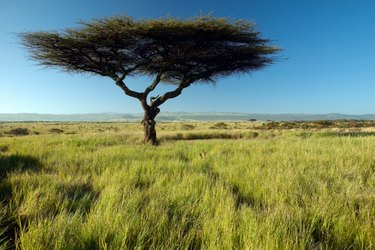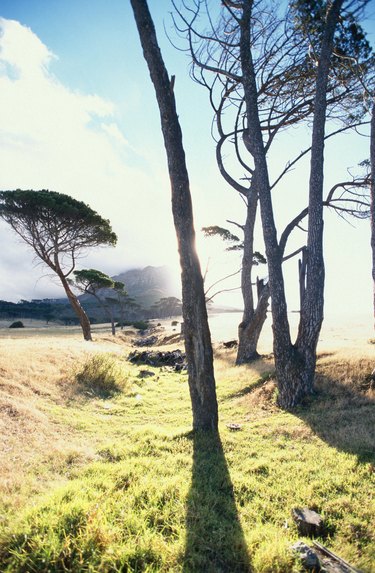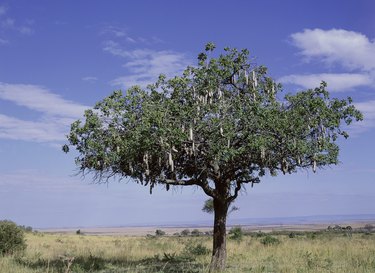
Tropical savannas present plants with dry soil, periodic fires and threats from herbivores. Plants that commonly grow in tropical savannas have made adaptations that allow them to withstand long periods of dryness, survive fires and protect themselves from grazing animals.
Water Retention
Video of the Day

Grasses in tropical savannas generally grow quickly during times when they get adequate water. When water becomes scarce, they turn brown to minimize water loss. They store nutrients and moisture in the roots while waiting for rain. Some trees only produce leaves during the wet season. These leaves tend to be small to retain water. Trees also can store water in trunks and use their long roots to reach deep water sources. Some plants also have specialized storage organs such as bulbs and corms.
Video of the Day
Fire Resistance

Grasses keep a supply of nutrients and water in the roots below the ground. As such, they can survive fires that usually only affect the parts of the plants above ground. Fire actually replenishes the soil with nutrients, encouraging plant growth. After a fire, the acacia tree can re-sprout from the root crown, which is located under the ground and suffers no significant damage from a fire. Some plants in the tropical savannas use heat and smoke from a fire for germination. Others also have bark or leaves that protect the lower layers of the plants.
Protection from Herbivores

Grasses in the tropical savannas grow from the base instead of the tips, so that they can immediately continue growing even if the tips are burned or eaten. Grasses also often contain substances that discourage animals from eating too much, for example by wearing down the animals' teeth or releasing toxins or unpleasant tastes. The acacia tree has sharp thorns to discourage herbivores from feeding on it. It also produces nectar that ants find attractive. The ants live in acacia thorns and protect the tree by stinging animals that eat the leaves. The ants also protect the tree from other insects. The acacia tree also pumps a poisonous alkaloid into its leaves when an animal feeds on them. The unpleasant substance stops the animal from eating more leaves. The acacia tree also releases a chemical into the air, prompting other acacia trees in the vicinity to pump the alkaloid into their leaves.